Stainless Steel Invisible Cable Rail
Made for the do-it-yourselfer and manufactured by AGS Stainless - Bainbridge Island, Washington. Now you can have a beautiful, professional-grade stainless steel cable rail for a fraction of the cost of like systems installed by a steel fabricator.
A Rainier cable deck railing system under the Clearview® brand uses Clearview® – Cables as infill between vertical posts and below a horizontal top rail. AGS – Cable Crimpers are required for crimping this type of infill.
Tools Needed
- Electric Drill
- AGS – 3/16″ Drill Bit
- 1/2″ Socket
- Level for plumbing the posts
- Tape Measure
- Pliers
- 7/16″ Wrench
- AGS – Cable Crimpers
- AGS – Cable Cutters
- Caulking Gun with a Spreading Stick
- BASF – Bonding Agent.
- Pencil
- Tape
- Rag/Non-Abrasive Scotch-Brite® Cleaning Pad
- Acetone
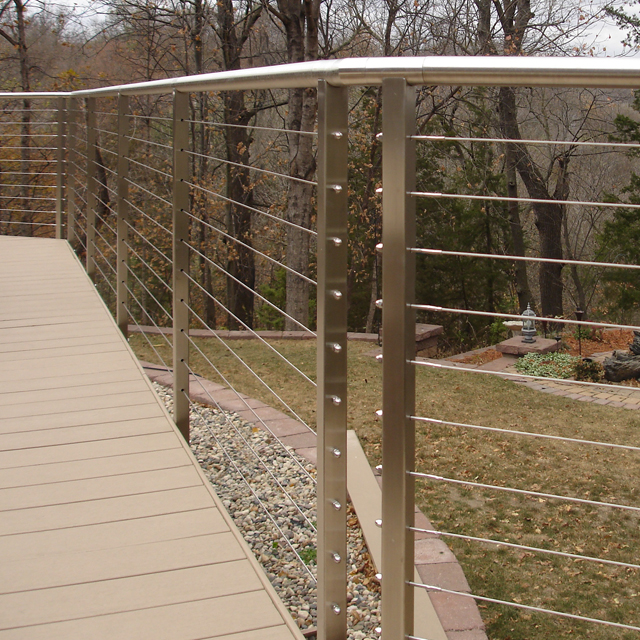
Side mounted deck cable railing.
Step 1: Layout and Mark the Location of your Railing System Posts
-
First, place the parts near the location of their installation.
-
Begin your installation at any corner by using the corner fitting to mark the connection location. The connection location will be used to calculate the post location.
-
Mark the post location 1″ away from the connection location. Post spacing is determined by many factors, which include side-load, wind-load, structural attachment method, and strength among others. These calculations are made during the design consultation stage of the process to meet safety standards.
Measure 8″ below the deck to determine where to side mount the post. Measuring is necessary because placing each post at a different height would prevent the top rail from being level.

Mark the connection location.
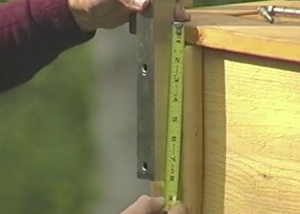
Measure 8″ below the deck.
Step 2: Install the Posts
-
Plumb the post with a level. Plumbing a post means making adjustments to ensure that it is completely vertical. Place the level against the side of the post. Adjust the level as needed until the bubble is centered between the two lines.
-
Drill the pilot holes while holding the drill as straight as possible. There are two holes needed for each post for the Clearview® – 3/8″ Lag Screw on the top and bottom. A pilot hole is a hole that is drilled as a guide for the installation of a screw and prevents the wood from splitting. For top mount posts, pilot holes can be drilled with an AGS – 3/16″ x 12″ Drill Bit, this long drill bit allows for more vertical holes.
-
Thread the Clearview® – 3/8″ x 5″ Lag Screws into the pilot holes by applying pressure to the heads and turning clockwise. Then tighten them with an impact wrench & socket, snug them enough to keep the post plumb in all directions.
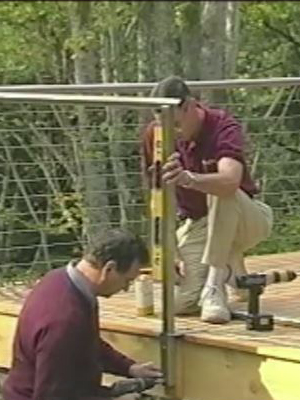
Use a level for plumbing the posts.
Step 3: Attach the handrailing
-
Spread BASF – Bonding Agent inside the connecting handrails to prevent them from rotating after being installed.
-
Install the handrails onto the post fittings. Twist the top rail 1/2 turn to spread the BASF – Bonding Agent around the post fitting and create a good bond.
-
Use acetone with a soft rag to remove excess BASF – Bonding Agent on the handrails and round post caps.
-
Use tape to hold the connections in place until the BASF – Bonding Agent cures to a tack, which takes approximately 24-72 hours. It fully cures in 7 days.
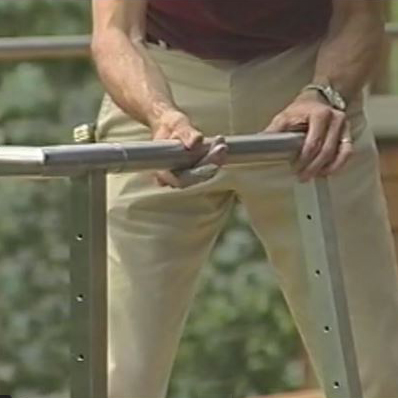
Attach the handrailing using a bonding agent.
Step 4: Attaching the Cable Fittings
-
Slide the Clearview® – Cable through all of the holes in the intermediate posts (the ones between the end posts).
-
To thread the end posts, pull the Clearview® – Cable through the hole in the end post. Rainier cable railing systems under the Clearview® brand generally use Clearview® – Cables. The posts are pre-drilled with a fiber laser cutting machine during the fabrication stage.
-
To cut the cable hold the Clearview® – Cable taut with one hand, hold the AGS – Cable Cutters against the post, and cut the Clearview® – Cable. AGS – Cable Cutters are made of hardened steel and have shear blades with a bypass design that are exceptional for use with Clearview® – Cables.
-
Crimp cable twice and insert the cable into the Clearview® – Standard Cable Fitting and crimp both sides for attaching a cable to a post. Crimping will be required unless swageless fittings are used, which can be released with a simple release key. Crimping cables involves inserting them into fittings. AGS – Cable Crimpers use compression for connecting a cable to a fitting.
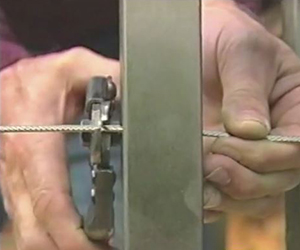
Cut the cables.
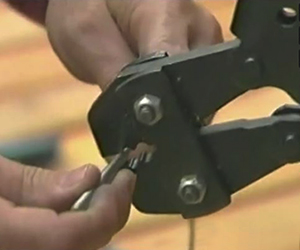
Use the crimpers to attach the cable fitting.
Step 5: Installing the Cables
-
Slip the Clearview® – Standard Cable Fitting – Exterior with an attached Clearview® – Cable through the end post and thread on a jam nut until 1/8″ of threads are exposed. Expose ONLY 1/8″ of threads beyond the jam nut, so that there will be sufficient space to tension the Clearview® – Cables and install the acorn nut. A stainless steel jam nut has a hexagon shape with a threaded hole through the center.
-
Thread an acorn nut on top of the jam nut. A stainless steel acorn nut has one capped end and a threaded hole in the other end. Acorn nuts provide a more finished look than exposed threads on the ends of Clearview® – Standard Cable Fittings – Exterior. Since acorn nuts have rounded ends, they will be much less likely to snag clothes or pet fur.
-
After all the cable fittings from one end of the run are installed, repeat steps 4 & 5 until all of the cables and fittings have been installed at both ends of the run.
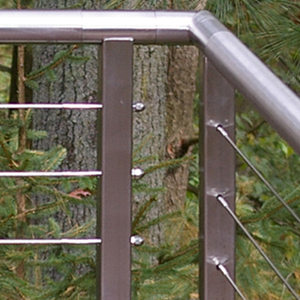
Attach the cable using a jam nut and acorn nut.
Step 6: Tensioning the Cables
-
Tighten jam nuts with a 7/16″ wrench to tension the Clearview® – Cables until they are “just” taut. If the cables are overly tightened, the combined force from the cables can bend or deform posts.
-
Using two 7/16″ wrenches, hold the jam nut in place with one wrench and tighten the acorn nut against the jam nut locking it in place.
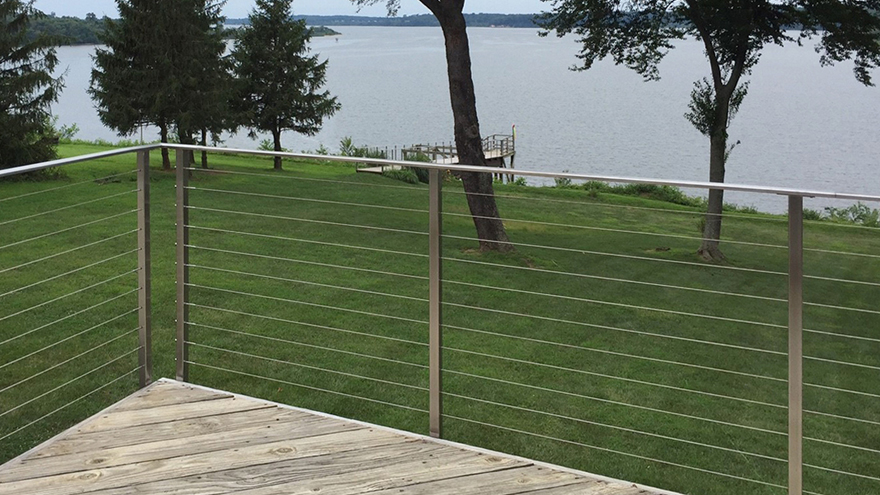
Do not over tension the cable railing.
Clean the railing system as needed and passivate the surface on a regular basis. Use a soft rag or non-abrasive cleaning pad rather than steel wool or steel brushes for cleaning to avoid cross-metal contamination or leaving scratches on stainless steel posts with a beautiful finish. The AGS – Stainless Steel Cleaning & Maintenance Kit includes a non-abrasive cleaning pad, passivation solution, and an instruction booklet that explains how to clean railings under the Clearview brand.
Step 7: Clean and Passivate
To clean stainless steel posts, apply some passivation solution on a soft rag or non abrasive pad and apply to the surface in same direction of the brushed finish grain. On round handrail the grain runs around the rail not lengthwise. Wait 15-30 minutes for the solution to completely clean and passivate the surface. Then rinse the surface with water.
To maintain a stainless steel railing system over the long term, a passivation solution will need to be applied periodically to recondition the surface. For making a stainless steel railing system shine in the short term, a non-chloride containing stainless steel cleaner can used as needed.
With the installation of your beautiful, invisible cable rail system complete, you can now enjoy the unobstructed view from your deck for many years to come.
Start Now! Submit a simple drawing and any relevant photos, a design consultant at AGS Stainless will work with you and/or your contractor to discuss expectations, measurements, applications, constraints, compliance, options, and maintenance. Your dedicated design consultant will then develop a cost estimate and a work plan for your consideration at no cost to you. Contact AGS Stainless today to schedule a FREE DESIGN CONSULTATION.

